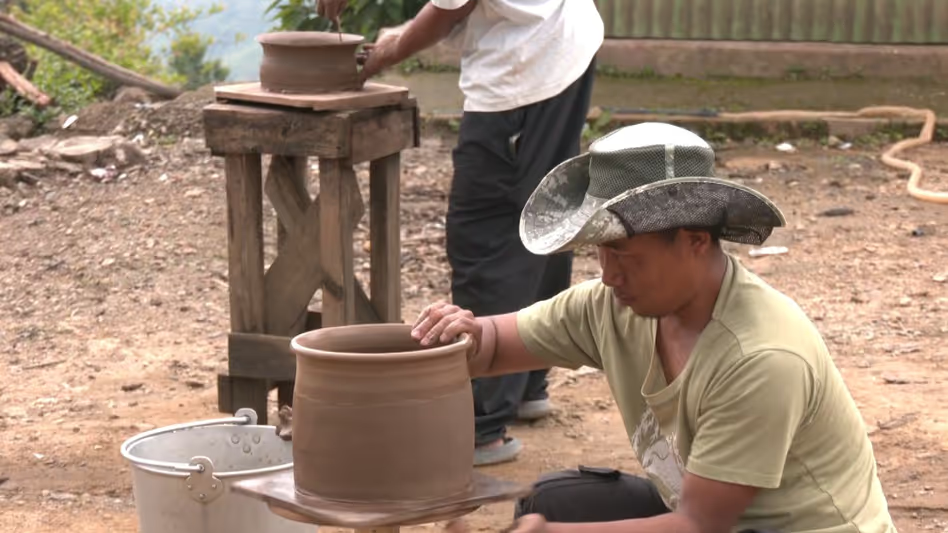“Ukhrul Black Pottery: How Nungbi Village Revived a Neolithic Craft for Modern Markets”
Summary of the News Article
In Ukhrul district’s Nungbi (Longpi) village, the centuries-old black pottery tradition is keeping around 200 families afloat, serving as their main livelihood. Made manually—without potter’s wheels—and fired in open kilns using a mix of crushed serpentine stone and natural clay, this eco-friendly craft produces durable, non-toxic cookware ideal for slow cooking. Though seasonal challenges persist due to monsoonal shelter issues, rising national demand for sustainable, handcrafted goods is shining a spotlight on this cultural heritage. Efforts continue to expand infrastructure and preserve this unique Tangkhul Naga art Handcrafted by the Tangkhul Naga community, it uses a special paste made from naturally available black serpentine stone and brown clay. What makes it pop is the absence of a potter’s wheel—everything is shaped by hand and moulded with paddles. These are then fired in open kilns and burnished with local leaves to achieve that elegant metallic sheen .
2. A Legacy Rooted in Myth and Ritual
Did you know there’s a legend behind this craft? According to folklore, Goddess Panthoibi crafted the first black pot to feed hungry people during creation itself . That’s why during festivals like Luira and Hampai Phanit, black pottery plays a sacred role, symbolizing life, prosperity, and divinity.
3. The Crafting Process: Hands at Work
Making these pots isn’t quick—it’s a labor of love:
- Clay Collection: November to April, villagers gather clay near Sala Hill, sun-dry it, and carry it home in baskets
- Stone Grinding: Serpentine rock is hand-ground into fine dust using mortar and pestle
- Mixing Dough: The mix—about 3:2 ratio of stone dust to clay—is formed into a pliable dough with water
- Shaping by Hand: Pots are formed by layering coils or paddling the dough around a mould—no wheels involved
- Sun Drying and Firing: Dried in shade then sun, these are later fired at around 800–900 °C in open kilns
- Polishing: A leaf-based burnish (e.g., Chiron Na) gives that trademark smooth, reflective black finish
4. Why Black Pottery Matters Today
4.1 Cultural Survival
This art connects Ukhrul’s youth with ancestral roots. Recent initiatives saw a revival—by 2023, around 30 young artisans (18–35) joined the craft, lifting it from near extinction
4.2 Economic Uplift
Artisans now earn roughly ₹30,000/month—remarkable in rural standards—thanks to demand from Delhi and Mumbai
4.3 Eco-Friendly & Functional
These pots are non‑toxic, durable, heat‑retentive, and perfect for slow cooking. They’re compatible with stoves, ovens, and microwaves—healthier and more sustainable than metal or plastic .
5. Challenges on the Road Ahead
5.1 Weather-Dependent Work
Monsoon rains stall production—without a communal workshed, artisans struggle for shelter
5.2 Infrastructure Gaps
To scale operations, the village needs kilns, storage, and transport upgrades.
5.3 Market Access
Middlemen dominate sales; direct ties to global crafts markets could increase profits.
5.4 Cultural Continuity
Younger generations need incentives to stay—financial, cultural, and infrastructural support is vital.
6. Supportive Moves & National Recognition
- National Awards: Machihan Sasa, Yaomi Sasa, and Diamond Luiram received awards for sustaining the art
- Padma Shri Honor: In 2024, Machihan Sasa received a Padma Shri! That spotlight showcased black pottery at a national level
- Documentation & Design Support: The National Institute of Design has studied and supported artisans
- Global Outreach: Efforts by Mathew Sasa and others have taken Longpi pottery to global craft fairs
7. A Pottery Renaissance: Voices of the Village
“Black pottery has always been part of our lives…” — artisan Worshang Awungshi, one of the young potters leading the revival
“A common workshed is essential…” — village leaders stressing the need to sustain craft through infrastructure
8. Weaving Tradition with Modern Trends
- Home Utility & Décor: Pots, kettles, mugs—all are trending as eco décor and cooking ware.
- Health Appeal: Earthware that’s chemical-free gains popularity among wellness enthusiasts
- Cultural Gifting: These heirloom pieces are perfect for weddings and festivals—a global audience is noticing.
Analogies & Rhetorical Sparks
- Like ancestral roots feeding a tree, this craft sustains modern livelihoods.
- Imagine a river rejuvenated—monsoon rains submerge potential, but proper shelter channels that flow into sustainable growth.
- Isn’t it magical that a clay pot can connect myth, health, culture, and economy all at once?
A Vision for the Future
Let’s visualize a village equipped with:
- Covered kilns and workshops,
- Online storefronts reaching global buyers,
- Skill-centered tourism drawing visitors during Shirui Lily Festival and other events,
- Cultural centers teaching pottery to school kids.
Conclusion
Ukhrul’s black pottery is a testament to human resilience and innovation. It’s not just a craft—it’s a connection to mythology, a path to economic dignity, and a promise of sustainable living. By bolstering infrastructure, celebrating artisans, and reaching modern markets, this ancient art can illuminate rural prosperity for generations. So next time you stir a stew in a glossy black pot, know that you’re holding a story—of soil, craft, spirit, and survival.
FAQs
1. What makes black pottery unique in crafting?
It uses serpentine rock + brown clay, is hand-built without a wheel, and polished with leaves—creating non-toxic, heat-retentive pots
2. How many families depend on this craft in Nungbi?
Around 200 families are directly involved in pottery—about 30 active youth and award-winning artisans lead the craft revival
3. Can these pots be used on modern stoves?
Yes! They’re safe on gas, open flames, ovens, and even microwaves. They retain heat and add culinary richness
4. What honors has this craft received?
Three National Awardees and a 2024 Padma Shri for Machihan Sasa have spotlighted Longpi pottery nationally
5. What infrastructure does the village need?
A shared workshed, better kiln facilities, storage, and direct market access are essential to overcome seasonal and logistical constraints





